英语语法主谓一致
- 格式:doc
- 大小:52.50 KB
- 文档页数:6
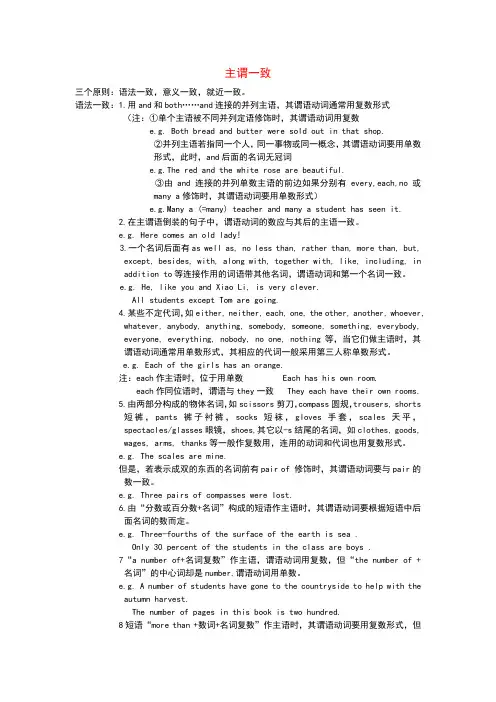
主谓一致三个原则:语法一致,意义一致,就近一致。
语法一致:1.用and和both……and连接的并列主语,其谓语动词通常用复数形式(注:①单个主语被不同并列定语修饰时,其谓语动词用复数e.g. Both bread and butter were sold out in that shop.②并列主语若指同一个人,同一事物或同一概念,其谓语动词要用单数形式,此时,and后面的名词无冠词e.g.The red and the white rose are beautiful.③由and连接的并列单数主语的前边如果分别有every,each,no或many a修饰时,其谓语动词要用单数形式)e.g.Many a (=many) teacher and many a student has seen it.2.在主谓语倒装的句子中,谓语动词的数应与其后的主语一致。
e.g. Here comes an old lady!3.一个名词后面有as well as, no less than, rather than, more than, but,except, besides, with, along with, together with, like, including, inaddition to等连接作用的词语带其他名词,谓语动词和第一个名词一致。
e.g. He, like you and Xiao Li, is very clever.All students except Tom are going.4.某些不定代词,如either, neither, each, one, the other, another, whoever,whatever, anybody, anything, somebody, someone, something, everybody,everyone, everything, nobody, no one, nothing等,当它们做主语时,其谓语动词通常用单数形式,其相应的代词一般采用第三人称单数形式。
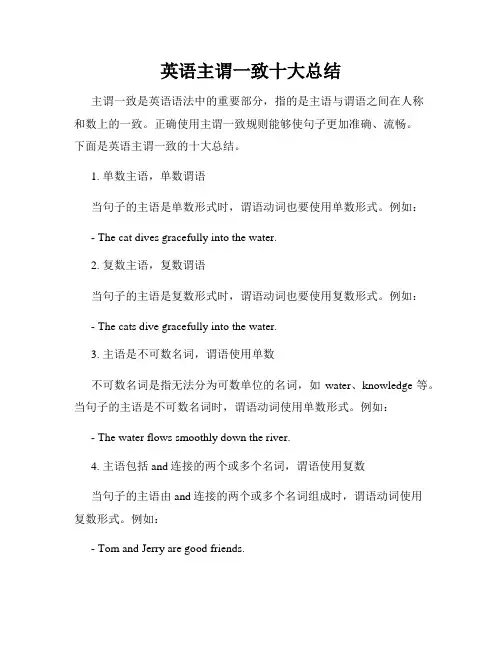
英语主谓一致十大总结主谓一致是英语语法中的重要部分,指的是主语与谓语之间在人称和数上的一致。
正确使用主谓一致规则能够使句子更加准确、流畅。
下面是英语主谓一致的十大总结。
1. 单数主语,单数谓语当句子的主语是单数形式时,谓语动词也要使用单数形式。
例如:- The cat dives gracefully into the water.2. 复数主语,复数谓语当句子的主语是复数形式时,谓语动词也要使用复数形式。
例如:- The cats dive gracefully into the water.3. 主语是不可数名词,谓语使用单数不可数名词是指无法分为可数单位的名词,如water、knowledge等。
当句子的主语是不可数名词时,谓语动词使用单数形式。
例如:- The water flows smoothly down the river.4. 主语包括and连接的两个或多个名词,谓语使用复数当句子的主语由and连接的两个或多个名词组成时,谓语动词使用复数形式。
例如:- Tom and Jerry are good friends.5. 主语包括either/or、neither/nor连接的两个名词,谓语与最近的名词保持一致当句子的主语由either/or、neither/nor等连接的两个名词组成时,谓语动词与最近的名词在人称和数上保持一致。
例如:- Either Tom or Jerry is responsible for the mess.6. 主语是集体名词,谓语根据上下文确定单复数集体名词指代一群人或事物的总称,如team、family等。
谓语动词的单复数形式根据上下文来确定。
例如:- The family goes to the park every weekend.7. 主语是某些固定短语时,谓语使用单数某些固定短语作为主语时,谓语动词使用单数形式。
例如:- Bread and butter is a common breakfast choice.8. 主语是以each、every、everyone、everything等开头时,谓语使用单数当句子的主语以each、every、everyone、everything等词开头时,谓语动词使用单数形式。

主谓一致所谓主谓一致是指主语和谓语动词之间,即主语的人称和单复数形式决定着谓语动词对应的形式。
主谓一致的三个原则:语法一致,就近一致,意义一致。
1.两个名词由and连接作主语时,谓语动词一般用复数。
Both Jack and Tim are diving.但如果连接两个以上的名词指的是同一个人或物, 或者指同一概念的时候, 谓语要用单数。
The singer and dancer is going to give us a performance.✧特别注意:用and 连接的成对名词习惯上被看成是一个整体如:bread and butter(黄油抹面包),knife and fork(刀叉)等作主语时,谓语动词用单数。
Whisky and soda is always his favorite drink.威士忌酒加苏打水是他是喜爱的饮品。
2.集合名词如public, family, class, crowd, population, team, group等作主语时, 如果强调整体,谓语动词用单数;指全体人员时, 动词则用复数。
His family is a large one. ( 强调整体)The family are all music lovers. (指家庭成员) 某些名词如people, police, cattle等,形式上是单数, 但意义上是复数, 谓语动词应用复数。
people指“民族”时是例外。
The police are searching for a thief.The cattle are eating grass on the hill.3.Everybody everything everyone somebody something someone anything anybody nobody nothing✧当这些词做主语时,谓语动词用单数,如Someone is asking for you.Nothing is found in the room.4.书名、时间、距离、价格、重量等的复数名词作主语时, 谓语动词常用单数。
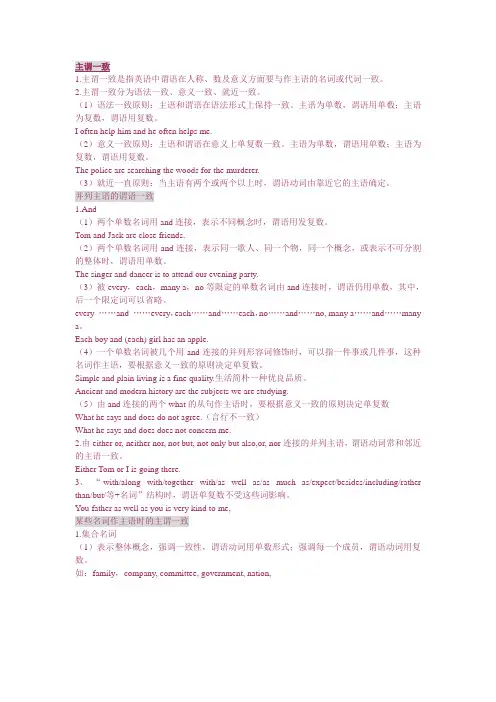
1.主谓一致是指英语中谓语在人称、数及意义方面要与作主语的名词或代词一致。
2.主谓一致分为语法一致、意义一致、就近一致。
(1)语法一致原则:主语和谓语在语法形式上保持一致。
主语为单数,谓语用单数;主语为复数,谓语用复数。
I often help him and he often helps me.(2)意义一致原则:主语和谓语在意义上单复数一致。
主语为单数,谓语用单数;主语为复数,谓语用复数。
The police are searching the woods for the murderer.(3)就近一直原则:当主语有两个或两个以上时,谓语动词由靠近它的主语确定。
并列主语的谓语一致1.And(1)两个单数名词用and连接,表示不同概念时,谓语用发复数。
Tom and Jack are close friends.(2)两个单数名词用and连接,表示同一歌人、同一个物,同一个概念,或表示不可分割的整体时,谓语用单数。
The singer and dancer is to attend our evening party.(3)被every,each,many a,no等限定的单数名词由and连接时,谓语仍用单数,其中,后一个限定词可以省略。
every ……and ……every,each……and……each,no……and……no, many a……and……many a。
Each boy and (each) girl has an apple.(4)一个单数名词被几个用and连接的并列形容词修饰时,可以指一件事或几件事,这种名词作主语,要根据意义一致的原则决定单复数。
Simple and plain living is a fine quality.生活简朴一种优良品质。
Ancient and modern history are the subjects we are studying.(5)由and连接的两个what的从句作主语时,要根据意义一致的原则决定单复数What he says and does do not agree.(言行不一致)What he says and does does not concern me.2.由either or, neither nor, not but, not only but also,or, nor连接的并列主语,谓语动词常和邻近的主语一致。

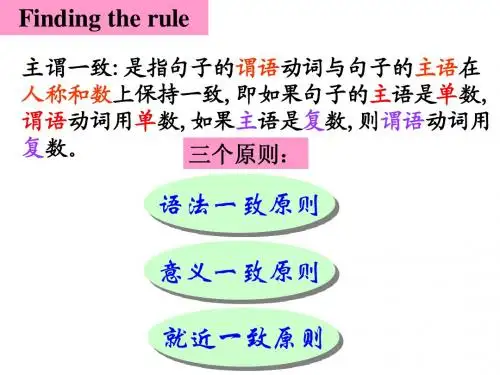
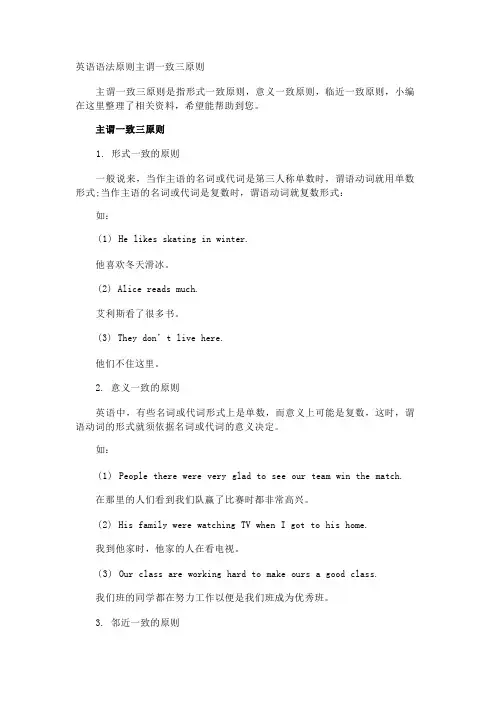
英语语法原则主谓一致三原则主谓一致三原则是指形式一致原则,意义一致原则,临近一致原则,小编在这里整理了相关资料,希望能帮助到您。
1. 形式一致的原则一般说来,当作主语的名词或代词是第三人称单数时,谓语动词就用单数形式;当作主语的名词或代词是复数时,谓语动词就复数形式:如:(1) He likes skating in winter.他喜欢冬天滑冰。
(2) Alice reads much.艾利斯看了很多书。
(3) They don’t live here.他们不住这里。
2. 意义一致的原则英语中,有些名词或代词形式上是单数,而意义上可能是复数,这时,谓语动词的形式就须依据名词或代词的意义决定。
如:(1) People there were very glad to see our team win the match.在那里的人们看到我们队赢了比赛时都非常高兴。
(2) His family were watching TV when I got to his home.我到他家时,他家的人在看电视。
(3) Our class are working hard to make ours a good class.我们班的同学都在努力工作以便是我们班成为优秀班。
3. 邻近一致的原则英语中,有时几个名词或代词有某些此连接起来一起作句子的主语,此时,谓语动词的形式就须有与之最接近的名词或代词的人称和数决定。
如:(1) There is a desk and five chairs in his room.他房间里有一张办公桌和五把椅子。
(2) There are five chairs and a desk in his room.他房间里有五把椅子和一张办公桌。
(3) Either you or Li Lei is going to be sent there.要么是你要么是李蕾将被派到那里去。
(4) Are either you or Li Lei going to be sent there.是你将被派到那里去还是李蕾将被派到那里去?基本句型一:S V (主+谓)主语:可以作主语的成分有名词(如 boy),主格代词(如you),动词不定式,动名词等。
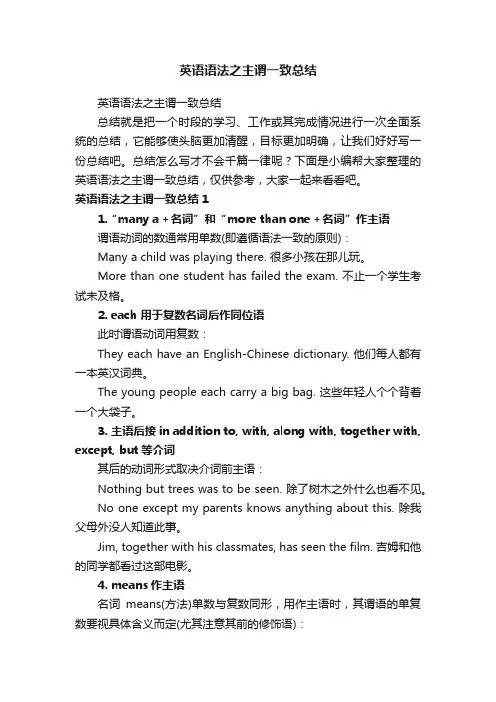
英语语法之主谓一致总结英语语法之主谓一致总结总结就是把一个时段的学习、工作或其完成情况进行一次全面系统的总结,它能够使头脑更加清醒,目标更加明确,让我们好好写一份总结吧。
总结怎么写才不会千篇一律呢?下面是小编帮大家整理的英语语法之主谓一致总结,仅供参考,大家一起来看看吧。
英语语法之主谓一致总结11.“many a +名词”和“more than one +名词”作主语谓语动词的数通常用单数(即遵循语法一致的原则):Many a child was playing there. 很多小孩在那儿玩。
More than one student has failed the exam. 不止一个学生考试未及格。
2. each 用于复数名词后作同位语此时谓语动词用复数:They each have an English-Chinese dictionary. 他们每人都有一本英汉词典。
The young people each carry a big bag. 这些年轻人个个背着一个大袋子。
3. 主语后接in addition to, with, along with, together with, except, but等介词其后的动词形式取决介词前主语:Nothing but trees was to be seen. 除了树木之外什么也看不见。
No one except my parents knows anything about this. 除我父母外没人知道此事。
Jim, together with his classmates, has seen the film. 吉姆和他的同学都看过这部电影。
4. means作主语名词means(方法)单数与复数同形,用作主语时,其谓语的单复数要视具体含义而定(尤其注意其前的修饰语):These means are very good. 这些方法很好。
Such a means is really unpleasant. 这样的方法确实是令人不愉快。
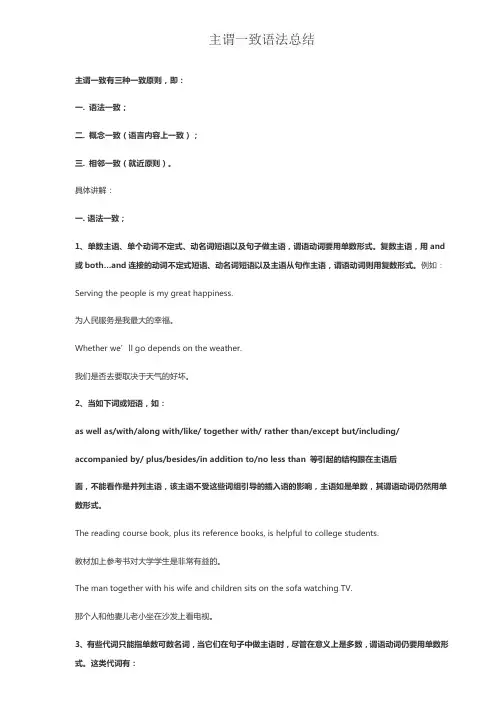
主谓一致语法总结主谓一致有三种一致原则,即:一. 语法一致;二. 概念一致(语言内容上一致);三. 相邻一致(就近原则)。
具体讲解:一. 语法一致;1、单数主语、单个动词不定式、动名词短语以及句子做主语,谓语动词要用单数形式。
复数主语,用and 或both…and连接的动词不定式短语、动名词短语以及主语从句作主语,谓语动词则用复数形式。
例如:Serving the people is my great happiness.为人民服务是我最大的幸福。
Whether we’ll go depends on the weather.我们是否去要取决于天气的好坏。
2、当如下词或短语,如:as well as/with/along with/like/ together with/ rather than/except but/including/ accompanied by/ plus/besides/in addition to/no less than 等引起的结构跟在主语后面,不能看作是并列主语,该主语不受这些词组引导的插入语的影响,主语如是单数,其谓语动词仍然用单数形式。
The reading course book, plus its reference books, is helpful to college students.教材加上参考书对大学学生是非常有益的。
The man together with his wife and children sits on the sofa watching TV.那个人和他妻儿老小坐在沙发上看电视。
3、有些代词只能指单数可数名词,当它们在句子中做主语时,尽管在意义上是多数,谓语动词仍要用单数形式。
这类代词有:either,neither,each one, the other ,another,somebody ,someone,something,anyone,anything,anybody,everyone,everything,everybody,no one,nothing ,nobody;例如:Neither likes the friends of the other.两人都不喜欢对方的朋友。
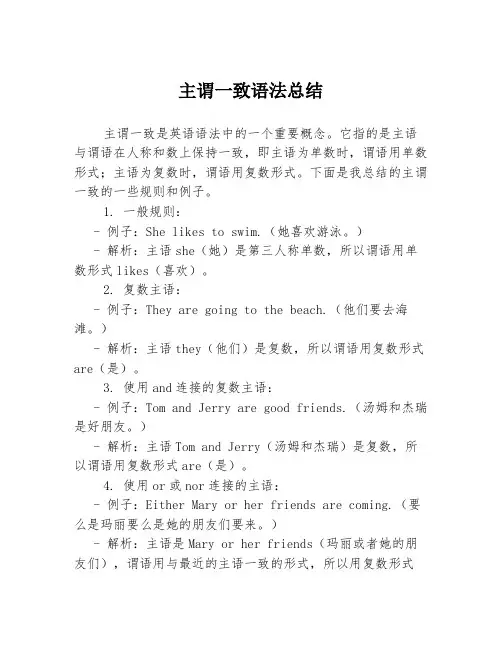
主谓一致语法总结主谓一致是英语语法中的一个重要概念。
它指的是主语与谓语在人称和数上保持一致,即主语为单数时,谓语用单数形式;主语为复数时,谓语用复数形式。
下面是我总结的主谓一致的一些规则和例子。
1. 一般规则:- 例子:She likes to swim.(她喜欢游泳。
)- 解析:主语she(她)是第三人称单数,所以谓语用单数形式likes(喜欢)。
2. 复数主语:- 例子:They are going to the beach.(他们要去海滩。
)- 解析:主语they(他们)是复数,所以谓语用复数形式are(是)。
3. 使用and连接的复数主语:- 例子:Tom and Jerry are good friends.(汤姆和杰瑞是好朋友。
)- 解析:主语Tom and Jerry(汤姆和杰瑞)是复数,所以谓语用复数形式are(是)。
4. 使用or或nor连接的主语:- 例子:Either Mary or her friends are coming.(要么是玛丽要么是她的朋友们要来。
)- 解析:主语是Mary or her friends(玛丽或者她的朋友们),谓语用与最近的主语一致的形式,所以用复数形式are(是)。
5. 使用each,every,either,neither等作为主语: - 例子:Every student has a textbook.(每个学生都有一本教科书。
)- 解析:每个学生是个别的,所以谓语用单数形式has (有)。
6. 谓语动词形式和主语一致:- 例子:The book is on the table.(书在桌子上。
) - 解析:主语the book(这本书)是第三人称单数,所以谓语用单数形式is(在)。
综上所述,主谓一致是指主语与谓语在人称和数上保持一致。
正确使用主谓一致是英语语法中的基本要求,需要根据具体的语境和语法规则来确定谓语形式。
希望以上总结可以帮助你理解主谓一致的规则。
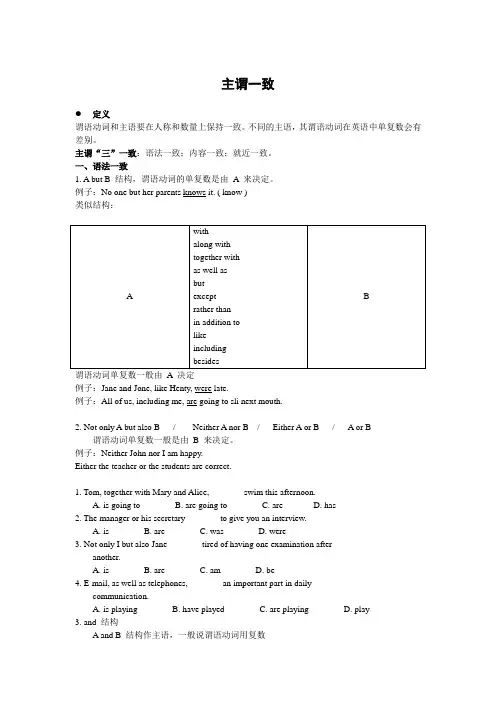
主谓一致定义谓语动词和主语要在人称和数量上保持一致。
不同的主语,其谓语动词在英语中单复数会有差别。
主谓“三”一致:语法一致;内容一致;就近一致。
一、语法一致1. A but B 结构,谓语动词的单复数是由A 来决定。
例子:No one but her parents knows it. ( know )类似结构:谓语动词单复数一般由A 决定例子:Jane and Jone, like Henty, were late.例子:All of us, including me, are going to sli next mouth.2. Not only A but also B / Neither A nor B / Either A or B / A or B谓语动词单复数一般是由B 来决定。
例子:Neither John nor I am happy.Either the teacher or the students are correct.1. Tom, together with Mary and Alice, _______ swim this afternoon.A. is going toB. are going toC. areD. has2. The manager or his secretary _______ to give you an interview.A. isB. areC. wasD. were3. Not only I but also Jane _______ tired of having one examination afteranother.A. isB. areC. amD. be4. E-mail, as well as telephones, _______ an important part in dailycommunication.A. is playingB. have playedC. are playingD. play3. and 结构A andB 结构作主语,一般说谓语动词用复数例:Tom and I are best friends.①看清到底是一个人还是两个人,通过定冠词来进行分析例题:The poet and writer has come. 表示一个人A poet and a writer have come.② each A and each B / every A and every B / many a A and many a B / no A and noB 作主语,谓语一般用单数例:Every man and every woman is asked to help.注意:many a 表示许多,等于 many③成对配套的可数名词后面一般用单数例:the knife and fork (刀叉)——> The knife and fork has been washed.a needle and thread 针线 a desk and chair 桌椅pen and ink 笔墨 a lock and key 锁和钥匙练习:1. A singer and dancer ___ present at the party.A. isB. areC. wasD. were2. Many a boy and many a student _______ looking forward to visiting theUnited States of America present.A. areB. wereC. isD. was3. The engineer and worker referred to ____ to design something.A. be goingB. are goingC. be likelyD. is going4. No bird and no beast _______ in the lonely island.A. are seenB. is seenC. seeD. sees4. 动名词/ 不定式/ 主语从句作主语,谓语动词一般用单数例:Walking is a good form of exercise.To perserve means victory.What I need is your love.练习:1. That they have cheated the boys ______ now clear to us all.A. isB. areC. wasD. were2. Writing stories and articles ______ what she enjoys most.A. isB. have beenC. wasD. were5. 如果名词被all / some / most / half / part / the rest / 分数/ 百分数等修饰时,谓语动词由主语决定。
第一讲主谓一致“一致”(Concord 或Agreement)是指句子成分之间词语之间在语法形式上的协调关系。
主要有主语与动词的一致,主语与补语的一致,限定词与名词中心词的一致,人称代词与并列和非并列先行词的一致,名词与名词或代词的一致。
“主谓一致”是指主语和谓语动词之间在人称和数的方面的一致关系,这又叫做“主——动一致”(Subject ——verb Concord)。
1. 主谓一致三原则主语和随后的动词(词组),即谓语动词之间的一致关系常为三种不同的原则所支配,即语法一致原则(Grammar Concord),意义一致原则(Notional Concord)和就近原则(Principle of Proximity)。
1.1 语法一致指作主语的名词中心词是复数,动词就用复数形式;如果名词中心词是单数名词或不可数名词,动词就用单数形式。
例如:Both boys have their own merits.In my heart are peace and goodwill.The elevator works very well.Much effort is wasted.1.2 意义∕概念一直指主语和动词的一致关系并非取决于语法上的单、复数形式,而是取决于主语的单、复数意义。
有时主语在语法形式上并非复数,但有复数意义,随后的动词就用复数;主语在语法形式上是复数,而在意义上可视为单数,随后的动词用单数。
例如:The jury has asked more time.The jury are unable to agree.Fifty minutes isn’t enough time to finish this test.“ Senior citizens” means people over sixty.1.3 就近原则指谓语动词的单、复数形式取决于最靠近它的词语的单、复数形式,而不是与充当主语的名词短语中心词相一致。
主谓一致的规则与注意点在英语语法中,主谓一致是指主语与谓语在人称和数上相互匹配的规则。
正确的主谓一致可以使句子更加通顺,准确地传达出所要表达的意思。
本文将介绍主谓一致的规则和注意点,并给出一些相关的例子。
一、一般情况下的主谓一致规则1. 单数主语与单数谓语动词一致:- The dog barks loudly.(这只狗吠叫得很大声。
)- My friend likes to read books.(我的朋友喜欢读书。
)2. 复数主语与复数谓语动词一致:- The birds fly south for the winter.(鸟儿们为了过冬飞向南方。
) - My parents are doctors.(我父母是医生。
)3. 不可数名词作为主语时,用单数谓语动词:- Physics is an interesting subject.(物理是一门有趣的科目。
)- Sugar tastes sweet.(糖的味道甜。
)4. 使用there is/are句型时,谓语动词与后面的主语一致:- There is a cat on the roof.(屋顶上有一只猫。
)- There are many books on the shelf.(书架上有很多书。
)二、特殊情况下的主谓一致规则1. 当主语由“each”, “every”, “either”, “neither”等修饰时,谓语动词用单数形式:- Each student needs to bring their own pen.(每个学生都需要带上自己的钢笔。
)- Neither of them is available tomorrow.(他们中的任何一个明天都不可用。
)2. 当主语由“either...or”, “neither...nor”, “not only...but also”等连接时,谓语动词与最靠近的主语一致:- Either the cat or the dogs are sleeping.(要么猫要么狗正在睡觉。
主谓一致的规则及应用主谓一致是英语语法中的基本规则,指的是主语与谓语在人称和数上保持一致。
正确运用主谓一致规则会增强句子的准确性和流畅性,使表达更加清晰。
本文将介绍主谓一致的规则,并给出一些应用实例。
一、基本规则1. 单数主语与单数谓语动词一致。
例如:- The cat is sleeping.(这只猫在睡觉。
)- She runs every morning.(她每天早上跑步。
)2. 复数主语与复数谓语动词一致。
例如:- The students are studying in the library.(学生们正在图书馆学习。
)- They play football every weekend.(他们每个周末踢足球。
)3. 不可数名词作主语时,谓语动词通常使用单数形式。
例如:- Rice is a staple food in many countries.(米饭是许多国家的主食。
)- Water is essential for life.(水对生命至关重要。
)4. 用作主语的不定代词通常与单数谓语动词一致。
例如:- Everyone wants to be happy.(每个人都想要快乐。
)- Somebody has left their bag here.(有人把包落在这里了。
)5. 连接词and连接的两个主语,谓语动词通常与复数一致。
例如:- Tom and Jerry are good friends.(汤姆和杰瑞是好朋友。
)- My mom and dad like gardening.(我爸爸妈妈喜欢园艺。
)二、特殊情况1. 数量词、百分数加名词短语作主语时,谓语动词取决于名词短语中的名词单复数形式。
例如:- Fifty percent of the students are girls.(百分之五十的学生是女孩。
)- A lot of money has been spent on this project.(这个项目花费了很多钱。
主谓一致主谓一致Subject-Verb Concord即谓语动词在人称和数上要和主语保持一致;主谓一致包括语法一致、意义一致和就近一致;语法一致即谓语动词在单复数形式上要和主语保持一致;意义一致就是谓语动词要和主语意义上的单复数保持一致;就近一致就是谓语动词要和靠近它的主语部分保持一致..表里不一主谓一致中的"表里不一"现象1;"more than one +名词"作主语时;谓语动词常用单数.例如:More than one teacher gets the flowers. 不止一个教师得到了花. 2;"many a +名词"作主语时;从意义上看是复数;但谓语动词常用单数.例如:Many a student has been sent to plant trees. 很多学生被派去植树.3;"half of ;the rest of ;most of ;all of及百分数或分数+of 等后接名词"作主语时;谓语动词形式根据of后的名词而定.例如:Three fourths of the surface of the earth is covered with water.地球表面四分之三为水所覆盖.4;all指人时;动词用复数;all指物时;动词用单数.例如:"All are present and all is going well." 所有人全部到场了;一切进展顺利5;what引导的主语从句;谓语动词可视表语而定:表语是单数名词时;动词用单数;相反;则用复数.例如:What they want to get are a number of good books.他们想得到的是大量的好书.6;and连接的两个单数名词前若用each ;every ;no修饰;该名词短语作主语时;谓语动词用单数形式.例如:No book and no pen is found in the schoolbag.书包里没有书和钢笔.7;当主语后面有as well as ;with ;along with ;together with ;but ;like ;rather than ;except;逗号加and连接几个名词等引导的短语时;谓语动词要与最前面的主语保持一致.例如:My father as well as his workmates has been to Beijing. 我父亲和他的同事曾去过北京.8;each作主语的同位语时;谓语动词由主语来决定;与each无关.例如:They each have a bike. 他们每人有一辆自行车.9;动词不定式;动词-ing形式短语作主语时;谓语动词常用单数.例如:Going out for a walk after supper is a good habit.晚饭后出去散步是一个好习惯.10;the following作主语时;谓语动词的数与后面名词的数保持一致.例如:The following are good examples下面是一些好例子.11;以-ics结尾的学科名词;如politics ;physics ;mathematics等作主语时;谓语动词用单数.以-s结尾的名词news ;works ;plastics等同属此类.例如:Politics is now taught in all schools. 现在各学校都开设政治课.当以-ics结尾的学科名词表示"学科"以外的意义时;用作复数;如:mathematics运算能力politics政治观点economics经济意义等..12;有些用来表示由两个对应部分组成一体的名词复数trousers ;glasses ;shoes .shorts .scissors .scales等作主语时;前面若有"一条";"一副";"一把"之类的单位词;动词用单数;若没有单位词或单位词是复数;则谓语动词用复数.例如:The shoes are all right. 这些鞋子都很合适.还有一些以-s结尾的名词通常用复数:arms武器.clothes .contents .minutes记录.remains遗体.thanks等13;"one and a half +名词"作主语时;谓语动词要用单数.例如:One and a half apples is left on the table. 桌子上有一个半苹果.14;"One or two more +复数名词"作主语时;谓语动词用复数.例如:One or two persons are sent there to help them do the work. 要派一两个人到那儿去给他们帮忙.15;"one of+复数名词+ 定语从句"结构中;定语从句的谓语动词要用复数;而在"the only one of +复数名词+定语从句"的结构中;"the one of + 复数名词+定语从句"定语从句的谓语动词要用单数.例如:He is one of the students who get there on time.他是准时到达那里的学生之一.16;表示时间;距离;金钱等的复数名词作主语表达一个整体概念时;谓语动词常用单数;但若强调数量;谓语动词可用复数.例如:One million dollars is a lot of money. 一百万美元是一大笔钱. -s结尾一以-s结尾的疾病名称作主语的主谓一致问题;以-s结尾的疾病名称作主语的主谓一致问题;如:arthritis ;bronchitis ;diabetes ;mumps ;phlebitis ;rickets;这类以-s结尾的疾病名称作主语时;谓语动词通常用作单数..例如:Arthritis causes great pain in the joints of the patient.二以-s结尾的游戏名称作主语的主谓一致问题;以-s结尾的游戏名称作主语时;谓语动词通常用作单数..例如:Darts is basically an easy game.但当Darts;Marbles等的意义为游戏器具而非游戏名称时;谓语动词通常用作复数..例如:Three darts are thrown at each turn.All nine skittles were brought down by the good throw.三以-s结尾的地理名称作主语的主谓一致问题;某些以-s结尾的地理名称;如果是国名;如the United States;the Netherlands等;因其是单一政治实体;所以谓语动词用作单数..例如:The United States was hit by the Great Depression in 1930s'.In early January 1996 the Netherlands was hit by its worst storm since 1976.但如果是群岛、山脉、海峡、瀑布等地理名称作主语;谓语动词用作复数..例如:The West Indies are commonly divided into two parts.四以-ics结尾的学科名称作主语的主谓一致问题;某些以-ics结尾的学科名称作主语时;如physics ;mathematics ;mechanics ;optics ;acoustics ;politics;st atistics ;economics ;linguistics ;athletics等;谓语动词通常用作单数..例如:The third world economics is promising.Athletics is a required course for students of all grades.但如果这类名词表示学科以外的其它含义;可作复数用..例如:Athletics have been greatly encouraged at this college.五其它以-s结尾的名词的主谓一致问题;.以-s结尾的由两部分组成的物体名称作主语;英语中有一些通常以-s结尾的由两部分组成的物体名词;如glasses ;pincers ;pliers ;scissors ;shorts ;suspenders ;trousers 等; 为复数名词;后接复数谓语集合名词1单数—复数型.凡是有复数词尾变化形式的集合名词都属于此类.如:a class—classes; a family—families; a government—governments; anarmy—armies ;a people—peoples民族; a group—groups; a crowd—crowds; a crew—crews等.这类集合名词强调的是整体性;即当作一个整体或多个整体来看待.属于这类集合名词的单数作主语时;谓语动词用单数;复数形式作主语时;谓语动词用复数.例如A big crowd often gathers on the square every morning.每个上午一大群人经常聚集在广场上The government has decided to pass the bill.政府已决定通过这一法案There are huge crowds in the streets on Sunday.星期天有大群大群的人在街上..There are many English-speaking peoples in the world.在世界上有许多讲英语的民族..但应注意;这类集合名词的单数形式有时表示复数概念;所以这些集合名词的单数形式也可归为"单复同形型"中.2单数型.这类集合名词表示的是人或事物的整体;即把这类人或事物的全部包括在内;所以只有单数形式.如作主语;谓语动词常用单数.这类名词常见的有:humanity ;mankind ;proletariat等.例如The proletariat is the greatest class in the history of mankind. In the fields of production and scientific experiment ;mankind makes constant progress.3复数型.这类集合名词在形式和内容上是相互矛盾的;就是说它们只有单数形式;但表达的都是复数概念.它强调的是集体中的个体性.这类名词有:police ;cattle ;faculty ;flock ;machinery ;vermin ;personnel等.它们作主语时;谓语动词要用复数.例如The police have caught the murder.Our personnel are very highly trained.The vermin are very dangerous.4单复同形型.这类集合名词的单数形式既可表示单数也可表示复数.作主语时;用单数动词或复数动词均可;有时意义区别不大;具体看语境;是强调集体还是个体..例如The school teaching staff are is excellent.The public is are requested not to litter in the park.The teaching profession claims to be badly paid.这类集合名词常见的有:class;family;team;crew;board;herd;committee;party;jury;enemy;au dience等.根据说话人的心理意向若把这个集合名词所代表的人或事物看作一个整体;就认为是单数;用单数动词;若把它所代表的人或事物看作若干个个体的话;就认为其为复数;用复数动词.试比较:The football team is playing well.那个足球队打得非常漂亮. The football team are shavings bath and are then coming back here for tea. 足球队员们正在洗澡;然后来这里吃茶点.The family is a very happy one.那个家庭是一个非常幸福的家庭.That family are very pleased about the news of William's success. 全家人对威廉的成功都感到很高兴.典型例题1 并列结构作主语时谓语用复数Reading and writing are very important.注意:当主语由and连接时;如果它表示一个单一的概念;即指同一人或同一物时;谓语动词用is;and 此时连接的两个词前只有一个冠词;共用一个冠词用单数;表示The iron and steel industry is very important to our life.The League secretary and monitor ___ asked to make a speech at the meeting.A. isB. wasC. areD. were答案 B. 注:先从时态上考虑.这是过去发生的事情应用过去时;先排除A.;C..本题易误选D;因为The League secretary and monitor 好象是两个人;但仔细辨别;monitor 前没有the;在英语中;当一人兼数职时只在第一个职务前加定冠词.后面的职务用and 相连.这样本题主语为一个人;所以应选B.2 主谓一致中的就近原则当there be 句型的主语是一系列事物时;谓语应与最邻近的主语保持一致.There is a pen;a knife and several books on the desk..There are twenty boy-students and twenty-three girl-students in the class.总的来说;在由not only…but also…;not just…but…;or;either…or…;neither…nor…连接主语的句子中及在there be句型中;谓语动词的单复数按就近原则处理;即按与谓语动词最靠近的那个主语来确定谓语动词的单复数形式..如:Not only John but also I am going to Shanghai next week.Either you or she is to go.There is a pen ;a few envelops and some paper for you.3 谓语动词与前面的主语一致当主语后面跟有with ;together with ;like; except ;but ;no less than ;as well as 等词引起的短语时;谓语动词与前面的主语一致.The teacher together with some students is visiting the factory. He as well as I wants to go boating.4 谓语需用单数1 代词each和由every ;some ;no ;any等构成的复合代词作主语;或主语中含有each ;every;谓语需用单数.Each of us has a tape-recorder.There is something wrong with my watch.2 当主语是一本书或一条格言时;谓语动词常用单数.The Arabian Night is a book known to lovers of English.<一千零一夜>是英语爱好者熟悉的一本好书.3 表示金钱;时间.距离.价格或度量衡的复合名词作主语时;通常把这些名词看作一个整体;谓语一般用单数.用复数也可;意思不变.Three weeks was allowed for making the necessary preparations. Ten yuan is enough.5 指代意义决定谓语的单复数1 在代词what ;which ;who ;none ;some ;any ;more ;most ;all等词的单复数由其指代的词的单复数决定.All is right. 一切顺利.All are present. 所有人都到齐了.2 集体名词作主语时;谓语的数要根据主语的意思来决定.如family ;team;group;club ;public ;audience ;crew ;crowd ;class ; company ;committee等词后用复数形式时;意为这个集体中的各个成员;用单数时表示该个集体.His family isn't very large. 他家不是一个大家庭.His family are music lovers. 他的家人都是音乐爱好者.但集合名词people ;police ;cattle ;poultry家禽.militia民兵.vermin 害虫等在任何情况下都用复数形式.Are there any police around3有些名词;如variety ;number ;population ;proportion ;majority 等有时看作单数;有时看作复数.A number of +名词复数+动词的第三人称单数形式.The number of +名词复数+动词非第三人称单数形式.A number of books have lent out.The majority of the students like English.6 与后接名词或代词保持一致1 用half of; part of ;most of ;a portion of 等词引起主语时;动词通常与of后面的名词;代词保持一致.Most of his money is spent on books.Most of the students are taking an active part in sports.2 在一些短语;如 many a 或 more than one 所修饰的词作主语时;谓语动词多用单数形式.但由more than… of 作主语时;动词应与其后的名词或代词保持一致.Many a person has read the novel. 许多人都读过这本书.More than 60 percent of the students are from the city.百分之六十多的学生都来自这个城市.7 the+形容词/国籍形容词..表示一类人/一国人;作主语;谓语动词用复数..8 the+姓氏的复数;表示一家人或两夫妇;作主语时;谓语动词用复数;9四则运算时;谓语动词用单数..10 表示;时间;距离;重量;金额;书名的复数名词作主语时;通常当做整体看待;谓语动词用单数..。
Lecture Seven理科班英语语法篇(七)主谓一致概述:1) 语法形式上要一致,即用作主语的名词中心词和谓语动词在单、复数形式上一致2) 意义上要一致,即主语和谓语的一致关系取决于主语的单、复数意义.1 并列结构作主语时当意义为复数时谓语用复数注意: 当主语由and连结时,如果它表示一个单一的概念,即指同一人或同一物时,谓语动词用单数,and 此时连接的两个词前只有一个冠词.The iron and steel industry is very important to our life.The League secretary and monitor ___ asked to make a speech at the meeting.A. isB. wasC. areD. were2 主谓一致中的靠近原则当there be 句型的主语是一系列事物时,谓语应与最邻近的主语保持一致.There is a pen, a knife and several books on the desk..There are twenty boy-students and twenty-three girl-students in the class.总的来说,在由not only…but also…, not just…but…, or, either…or…, neither…nor…连接主语的句子中及在there be句型中,谓语动词的单复数按就近原则处理,即按与谓语动词最靠近的那个主语来确定谓语动词的单复数形式。
如:Not only John but also I am going to Shanghai next week.Either you or she is to go.Here is a pen, a few envelops and some paper for you.3 谓语动词与前面的主语一致当主语后面跟有with, together with, like, except, but, no less than, as well as 等词引起的短语时,谓语动词与前面的主语一致. The teacher together with some students is visiting the factory. He as well as I wants to go boating.4 谓语需用单数1) 代词each和由every, some, no, any等构成的复合代词作主语,或主语中含有each, every, 谓语需用单数. Each of us has a tape-recorder. There is something wrong with my watch.2) 当主语是一本书或一条格言时,谓语动词常用单数.The Arabian Night is a book known to lovers of English.< The Arabian Night >是英语爱好者熟悉的一本好书.3) 表示金钱,时间.距离.价格或度量衡的复合名词作主语时,通常把这些名词看作一个整体,谓语一般用单数.(用复数也可,意思不变.) Three weeks was allowed for making the necessary preparations. Ten yuan is enough.5 指代意义决定谓语的单复数1) 在代词what, which, who, none, some, any, more, most, all等词的单复数由其指代的词的单复数决定. All is right. (一切顺利.) All are present. (所有人都到齐了.)2) 集体名词作主语时,谓语的数要根据主语的意思来决定.如family, audience, crew, crowd, class, company, committee等词后用复数形式时,意为这个集体中的各个成员,用单数时表示该个集体. His family isn'tvery large. 他家不是一个大家庭.His family are music lovers. 他的家人都是音乐爱好者.但集合名词people, police, cattle, poultry(家禽).militia(民兵).vermin等在任何情况下都用复数形式. Are there any police around3)有些名词,如variety, number, population, proportion, majority 等有时看作单数,有时看作复数. A number of +名词复数+复数动词. The number of +名词复数+单数动词.A number of books have lent out. The majority of the students like English.6 与后接名词或代词保持一致1) 用half of, part of, most of, a portion of 等词引起主语时,动词通常与of后面的名词,代词保持一致. Most of his money is spent on books.Most of the students are taking an active part in sports.2) 在一些短语,如many a 或more than one 所修饰的词作主语时,谓语动词多用单数形式.但由more than… of 作主语时,动词应与其后的名词或代词保持一致.Many a person has read the novel. 许多人都读过这本书.More than 60 percent of the students are from the city.百分之六十多的学生都来自这个城市.主谓一致中的"表里不一"现象和主语必须在人称和数上保持一致,最基本的原则是:单数主语用单数动词,复数主语用复数动词.但在实际使用当中情况比较复杂,现在学生常犯的主谓一致错误归纳整理如下1,"more than one +名词"作主语时,谓语动词常用单数.例如:More than one teacher gets the flowers. 不止一个教师得到了花.2, "many a +名词"作主语时,从意义上看是复数,但谓语动词常用单数.例如:Many a student has been sent to plant trees. 很多学生被派去植树.3,"half of, the rest of, most of, all of及百分数或分数+of 等后接名词"作主语时,谓语动词形式根据of后的名词而定.例如:Three fourths of the surface of the earth is covered with water.地球表面四分之三为水所覆盖.4,all指人时,动词用复数;all指物时,动词用单数.例如:"All are present and all is going well." 所有人全部到场了,一切进展顺利5,what引导的主语从句,谓语动词可视表语而定:表语是单数名词时,动词用单数,相反,则用复数.例如:What they want to get is the number of good books.他们想得到的是大量的好书.6,and连接的两个单数名词前若用each,every,no修饰,该名词短语作主语时,谓语动词用单数形式.例如: No book and no pen is found in the schoolbag.书包里没有书和钢笔.7,当主语后面有as well as, with, along with, together with, but, like, rather than, except等引导的短语时,谓语动词要与最前面的主语保持一致.例如:My father as well as his workmates has been to Beijing. 我父亲和他的同事曾去过北京.8,each作主语的同位语时, 谓语动词由主语来决定,与each无关.例如:They each have a bike. 他们每人有一辆自行车.9,动词不定式,动词-ing形式短语作主语时,谓语动词常用单数.例如:Going out for a walk after supper is a good habit.晚饭后出去散步是一个好习惯.10,the following作主语时,谓语动词的数与后面名词的数保持一致.例如:The following are good examples下面是一些好例子.11,以-ics结尾的学科名词,如politics,physics,mathematics等作主语时,谓语动词用单数.以-s结尾的名词news, works, plastics等同属此类.例如:Politics is now taught in all schools. 现在各学校都开设政治课.当以-ics结尾的学科名词表示"学科"以外的意义时,用作复数,如:mathematics(运算能力)politics(政治观点)economics(经济意义)等12,有些用来表示由两个对应部分组成一体的名词复数(trousers, glasses,shoes.shorts.scissors.scales等)作主语时,前面若有"一条","一副","一把"之类的单位词,动词用单数;若没有单位词或单位词是复数,则谓语动词用复数.例如:The shoes are all right. 这些鞋子都很合适.还有一些以-s结尾的名词通常用复数:arms(武器).clothes.contents.minites(记录).remains(遗体).thanks等13,"one and a half +名词"作主语时,谓语动词要用单数.例如:One and a half apples is left on the table. 桌子上有一个半苹果.14,"One or two more +复数名词"作主语时,谓语动词用复数.例如:One or two persons are sent there to help them do the work. 要派一两个人到那儿去给他们帮忙.15,"one of+复数名词+ 定语从句"结构中,定语从句的谓语动词要用复数;而在"the only one of +复数名词+定语从句"的结构中,定语从句的谓语动词要用单数.例如: He is one of the students who get there on time.他是准时到达那里的学生之一.16,表示时间,距离,金钱等的复数名词作主语表达一个整体概念时,谓语动词常用单数,但若强调数量,谓语动词可用复数.例如:One million dollars is a lot of money. 一百万美元是一大笔钱.练习1. Neither of them ______ going to the cinema. Both of them _____ going to the cinema.A. is ; areB. is ; isC. are ; wasD. are ; is2. All but one _____ here just now. All that I want to say ____ this.A. was; wereB. was; isC. were; isD. were; were3. A number of students ____ gone for an outing. The number of the students ______ increasing year.A. have; hasB. is; haveC. has; haveD. have; is4. Some of the oranges ______ turned bad. Some of the milk _______ turned sour (酸).A. have; hasB. have; haveC. has; haveD. have; is5. Each student -____ got an English- Chinese dictionary. The students each ______ a dictionary.A. have; hasB. has; haveC. have; haveD. has; has6. There _____ a pen, an ink bottle, and some books on it. There ________ some bowls, plates and a spoon on it.A. is; areB. are; areC. are; isD. is; is7. Either the judge or the lawvers ________ wrong. Either you or he _______ to blame.A. is; areB. are; isC. are; areD. is; is8. His family ______ all very well. His family _______ a “ five good” one.A. are; isB. is; isC. are; areD. is; are9. My blue trousers ______ worn out. One pair of trousers ______ not enough.A. is; areB. are; areC. is; isD. are; is10. Our League secretary and monitor ______ the lead in everything. Our League secretary and the monitor ______ good friends.A. take; areB. take; isC. takes; isD. takes; are11. The girl as well as his parents _______ a bike. Not only the students but also the professor ______ surprised at Mary’s answer.A. have; wasB. have; wereC. has; wasD. has; were12. Who _____ the girl singing in the next room? Who ______ these people over there?A. are; areB. are; isC. is; areD. is; is13. Most of the students _____ boys. Most of his money _____ spent on books.A. are; isB. is ; isC. are; areD. is; are14. The policeman ______ standing at the street corner. The police _____ searching for him.A. are; isB. are; areC. is; areD. is; is15. The glasses ______ mine. That pair of glasses _____ my brother’s.A. are; isB. are; areC. is; areD. is; is16. The news at six o’clock _____ not true. Those pieces of news _____ to be broadcasted.A. are; isB. are; areC. is; areD. is; is17. Grandpa Wang and his two grandsons ______ taking a walk in the park now. Grandpa Wang, together with his two grandsons, ____ taking a walk in the park now.A. are; areB. is; areC. is; isD. are; is18. No one but Jane ______ the secret. Nobody but Mary and I ___ in the classroom at that time.A. know; wasB. knows; wasC. know; wereD. knows; were19. There _______ nothing but two looms in the hall. There _____ something wrong with the machine.A. was; isB. was; areC. were; isD. were; are20. He is one of the boys who _____ never late for school. He is the only one of the boys who _____ never late for school.A. is; areB. are; areC. are; isD. is; is21. What they have done ______ of great use to us. What he says and what he does ___ agree.A. is; notB. is; do notC. are; does notD. are; not22. Every picture except these two _______. Everything around us _____ matter.A. have been sold; isB. have been sold; areC. has been sold; isD. has been sold; are23. A woman with two children ______ coming up to us. Mary, along with her parents, ___ moved to Paris.A. is; hasB. is; haveC. are; haveD. are; has24. one sixth of our classmates _____ from peasant families. One fifth of her time ____ devoted to writing.A. comes; isB. come; areC. come; isD. comes; are25. Only 10 percent of the students in the class _____ League members. About 40% of Jim’s income ________ to the rent (租金).A. are; goesB. are; goC. is; goesD. is; go26. It is this teacher who ______ leaving for London. It is you who ____ next.A. are; areB. is; areC. are; isD. is; is27. The population of the earth _____ increasing fast. One third of the population here _____ workers.A. is; areB. is; isC. are; isD. are; are28. This kind of snakes _____ very dangerous. These kinds of metal _____ hard to find.A. is; isB. are; isC. is; areD. are; are29. Half of the visitors _____ from Europe. Half of the fruit _____ bad.A. is; areB. is; isC. are; isD. are; are30. Every man worker and every woman worker _____ free medical care. At Christmas each boy and each girl _____ given a present.A. enjoy; isB. enjoy; areC. enjoys; isD. enjoys; are31. Many a man ______ seen the wonderful film. Many men _____ seen the wonderful film.A. has; hasB. has; haveC. have; hasD. have; have32. Going to bed early and getting up early _____ a good habit. Singing and dancing _____ two of the things that he likes best.A. is; isB. are; isC. is; areD. are; are33. Such ______ Albert Einstein, a simple man of great achievements. Such ______ her words.A. were; wereB. was; wereC. were; wereD. was; was34. Besides Xiao Wang, Wiao Ma _____ willing to do the work. The factory, including its machines _____ burnt last night.A. was; isB. were; isC. was; areD. were; are35. If anybody _____, ask him to wait. _____ there anything I can do for you?A. come; IsB. come; AreC. comes; AreD. comes; Is36. Chinese _____ not so difficult to learn. The Chinese people ________ brave and hard working.A. is; isB. are; isC. is; areD. are; are37. Little _____ done to prevent the air from being polluted. Much _____ done to against fight pollution.A. has been; have beenB. have; hasC. has been; has beenD. have been; have been38. Do you know the singer and dancer who _____standing at the gate? China has thousands of islands, the largest of which ____ Taiwan.A. is; areB. is ; isC. are; isD. are; are39. Each of the girls ____ an orange. Each ______ his duty.A. have; hasB. have; haveC. has; hasD. has; have40. When we are to hold the sports meet ____ been decided. Whether he succeeds or fails ______ matter.A. have; don’tB. has; don’tC. have; doesn’tD. has; doesn’t41. Her clothes ____ nearly worn out. His physics ______ weaker than others.A. is; isB. are; isC. is; areD. are; are42. Five hundred dollars ______ more than he can afford.A. isB. are43. Food and clothing ____ daily necessities for people.A. isB. are44. The United Nations ___ trying to persuade the two countries.A. isB. are45. Three kilometers ____ not a long distance.A. isB. are46. To say something _______ one thing, to do it _____ another.A. is; isB. are; are47. Reading English magazines and novels ____ helpful to your study of English.A. isB. are48. He like you and Xiao Liu ______ very diligent.A. isB. are49. Between the two buildings _____ a hospital.A. standB. stands50. How to get rid of these things ____ a big problem.A. areB. is理科班英语语法篇(七)主谓一致答案:1—5 ACDAB 6—10ABADD 11—15CCACA 16—20CDBAD21—25BCACA 26—30BACCC 31—35BCBAD 36—40CCBCD41—45BABAA 46—50AAABB。